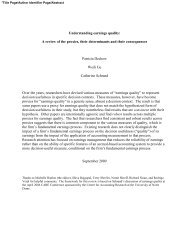Nintendo's “Revolution” - MIT Sloan School of Management
Nintendo's “Revolution” - MIT Sloan School of Management
Nintendo's “Revolution” - MIT Sloan School of Management
Create successful ePaper yourself
Turn your PDF publications into a flip-book with our unique Google optimized e-Paper software.
NINTENDO’S “REVOLUTION”<br />
Sangbeom Kim, Ian Lamont, Hiroshi Ogasawara, Mansoo Park, Hiroaki Takaoka<br />
had to be backwards compatible with games made for older Nintendo consoles like the GameCube,<br />
which used traditional two-handed controllers.<br />
Additionally, Iwata was very sensitive to the reaction <strong>of</strong> the gaming industry and the existing gaming<br />
population to a non-traditional product aimed at a non-traditional audience. Nintendo had a long<br />
history <strong>of</strong> video game success, epitomized by the popular Mario Bros. franchise invented by<br />
Nintendo’s game design guru Shigeru Miyamoto in the 1980s. However, the company’s last console,<br />
the GameCube, was unable to get sufficient traction after it was launched in 2001. In 2002, sales<br />
forecasts for the GameCube had been <strong>of</strong>f by 44% and the company had been forced to cut revenue<br />
targets by ¥100 billion. 2 Gamers much preferred Sony’s PlayStation 2 console and Micros<strong>of</strong>t’s Xbox<br />
console, 3 which were characterized by flashy graphics and hardcore fighting and sports titles. Iwata<br />
needed a home run to put Nintendo back on its feet. Could the Revolution’s radical hardware design<br />
help turn the company’s fortunes around?<br />
History <strong>of</strong> Video Games<br />
1960s-1970s<br />
Video games have been around since the early 1960s. In 1962 <strong>MIT</strong> students Steve Russell, Martin<br />
Graetz and Wayne Witaenem developed Spacewars, the first video game. Spacewars marked the first<br />
time that computer graphics were used in a game. It quickly gained popularity among hackers and<br />
computer geeks, 4 but never had a mainstream audience, owing to the fact that most people did not<br />
have computer access.<br />
In the late 1960s, Alan Kay developed the Dynabook, an early personal computer, which was targeted<br />
at children. The Dynabook concept set the stage for both the PC and computer game revolutions in<br />
the 1970s. 5 The first game console was the Magnavox Odyssey, developed by engineer Ralph Baer as<br />
a side project in 1972. 6 The following year, U.S.-based Atari launched a simple table tennis game<br />
called Pong in the United States, which could be hooked up to a TV set. 7 It was a hit. In 1977, the<br />
company released a more sophisticated game console, the Atari 2600, which let users load different<br />
games into the system using rectangular cartridges. It was an even bigger hit, selling more than 30<br />
million units. 8<br />
2 David Teather, “Nintendo in Sales,” The Guardian, March 8, 2003. Accessed from<br />
http://www.guardian.co.uk/technology/2003/apr/08/business.onlinesupplement in December 2010.<br />
3 Ibid.<br />
4 <strong>MIT</strong> 150 Exhibition “Spacewar! Steve Russell, Martin Graetz, and Wayne Witaenem, 1961–1962.” Accessed from http://museum.mit.edu/150/25 in May<br />
2011.<br />
5 Pete Markiewicz, “Plyojump - Computer History.” Accessed from http://www.plyojump.com/classes/microcomputer_era.html in May 2011.<br />
6 Philip Likens, “Ralph Baer: The Magnavox Odyssey.” Accessed from http://dept<strong>of</strong>.com/?p=185 in May 2011.<br />
7 Pete Markiewicz, “Plyojump - Computer History - Computer and Console Games (1952-Present).” Accessed from<br />
http://www.plyojump.com/classes/computer_games.html in May 2011.<br />
8 Ge<strong>of</strong>f Edgers, “Q&A: A Talk with Nick Montfort: Atari and the Deep History <strong>of</strong> Video Games,” Boston Globe, March 8, 2009. Accessed from<br />
http://www.boston.com/bostonglobe/ideas/articles/2009/03/08/a_talk_with_nick_montfort/ in December 2010.<br />
October 18, 2011 2
















